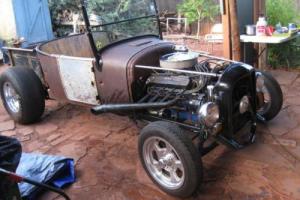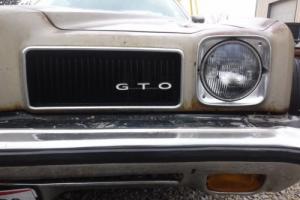Classic Cars / Bond / Car for sale
1973 Pontiac GTO GTO 4 SPEED
Sale price: $US $7,576.00 make an offer
Pending offers
Date: 2018-05-15
Steven Levine (from Smithtown,N.Y.) offered usd
Sale type: Fixed price listing
Technical specifications, photos and description:
- Year:
- 1973
- Mileage:
- 30,999
- Engine:
- 400 PONTIAC 4 bbl
- Got questions?
- Ask here!
1973 Pontiac GTO GTO 4 SPEED for sale
Current customer rating:EBAY PONTIAC BUYER. YOU HAVE NOW FOUND A VERY RARE CAR
for sale here and now is a 1973 PONTIAC GTO FACTORY 4 SPEED SPORTS COUPE
ASCOT SILVER with BLACK INTERIOR
POSITRACTION 3:23 to 1
FACTORY TACH
4-SPEED CONSOLE
REAR WINDOW DEFOG
RALLY II WHEELS
REAR SWAY BAR
fresh brakes
great patina aka needs paint
this car needs full restoration OR
turns heads BIGTIME making the scene as is
EVERYONE FREAKS OUT WHEN THEY SEE IT
MANY HAVE NEVER SEEN a 73 GTO
the original build sheet is above the tank
previous owner photographed the deteriorating build sheet and placed it back above tank
you will find an image of this car's ACTUAL build sheet in the photos--
in the lower right you will see option code W 62 (GTO)
THIS IS A RARE. SPECIAL CAR
original owner had GM replace motor under warranty
motor runs --- it seems to be starving for fuel but drives. shifts and stops well -
the gearing makes the car seem like it will go very fast top-end. a highway gear.
73 GTOs have what is known to GTO guys/girls as "THE TALL SPINDLE SWAP".
Buy this and drive as is. OR. stick a Hi-PO Pontiac in it or a JIM BUTLER 455
and have a "REAL STREET SWEEPER" here.
VERY COMPLETE. less original air cleaner - car comes with Quadrajet (not shown) and a Holley 4 BBL
that fuels it now
GTO is being sold as "NEEDS RESTORATION" but is Drivable / SHOWABLE AS-IS--
People love it's PATINA and many say "DON'T PAINT IT" but this rare car deserves a full resto.
car sold as is; where is in 43138 se ohio
buyer will assist shipper in loading and coordination--
or delivery by seller is an option for a fee
CLEAR. CLEAN RECENT OHIO TITLE in my name
the car will need a right (pass. side) fenderwell. right fender and a trunk lid when it is restored
the windshield needs to be replaced has cracks -
The tires are MAYPOPS. as in may pop anytime.
there are areas of rust that are repairable---
the car is not a rust bucket ---It will need some rust repair --
trunk floor is mostly good and floors look good from under the car--
I HAVE NOT PULLED CARPET OUT--
drivers seat needs recovering and carpet although mostly good is 44-45 years old--
once again the car is very original and needs full restoration.
please ask all questions or ask for any pics you need as this sale will be final--
below is information taken from the web regarding the
VERY COOL1973 4 SPEED GTOs
This car does all the GTO things. sounds. curb appeal. handling. cool factor
seller is THIRD OWNER
Speedometer shows 30. 99 as of listing. Speedo "bounces" so mileage showing is not true
PLEASE read my feedback and see what buyers say about truth in advertising.
don't miss this one. click BUY IT NOW or contact buyer directlythis car is offered for sale locally and in other places.
no reserve
DON'T GET SNIPED! BUY IT NOW OR BE SURE TO BE READY FRIDAY. APRIL 7TH WITH TWO BROWSERS OPEN DURING COUNTDOWN
----------------------------
The GTO option was available on two body styles. the LeMans Coupe or LeMans Sport Coupe. The quick way to tell the difference in the two is the rear quarter windows. on the Coupe these are exposed. flush with the body. while the Sport Coupe windows are inset and covered by louvers. In both cases they are fixed and do not roll down. As the name implies. the window treatment on the Sport Coupe gave it a much sportier look which buyers favored. Just under 500 of the Coupes were sold. Likewise buyers preferred the automatic transmission as just over 900 of the standard shifts were sold.
A colonnade is a sequence of columns connected by their own entablature. the horizontal structure that runs across the top to help keep the columns from toppling. The term "Colonnade" is also used to describe a 1973 Pontiac GTO. or any intermediate GM A-body produced from 1973-'77. These cars have columns--or. more accurately. pillars--which are connected by an entablature of steel roofs. some of which are finished in the finest vinyl. The A-bodies are also connected by a corporate entablature of shared parts and platform-swapping that produced some groundbreaking cars in the beginning. but was almost the end of GM 30 years later. The 1973 Pontiac GTO is a one-year beast so rare that some refuse to believe it ever existed. To them. the car is a Le Mans in clever disguise. driven by a guy wearing a Nixon mask. Article continues after advertisement No. the 1973 Pontiac GTO really does exist. though not in large numbers: only 4. 06 cars were produced during a tumultuous year. Elvis was belting out the hits live via satellite from Hawaii. drawing in more viewers than the moon landing. President Nixon told a throng of reporters that no. he was not a crook. Soviet Premier Leonid Brezhnev addressed Americans through their own TV sets. Gasoline prices skyrocketed in conjunction with an oil embargo. Federal regulations began to affect automobiles. Energy-absorbing bumpers hung off cars like sad afterthoughts. Emissions requirements hobbled engines once famous for their abundant horsepower. Still. not all was bad on the automotive front. While some dislike the '73 GTO's design quirks. others are beginning to look back at these stylish cars with Colonnade-colored glasses. Freedom of choice is what we want. and any car that has dual NACA ducts on the hood has to be good. ENGINES
Pontiac GTO buyers had a choice of two V-8 powerplants for 1973. The standard 400-cu. in. L78-code engine kicked out 230 horsepower. while the optional 455-cu. in. L75 code D-port V-8 did a little better with a 250hp rating. Only 544 cars rolled off the assembly line with the 455--perhaps a sad sign of the times. given the era's rising gas prices and declining performance standards. By 1973. the feds were tightening their grip on emissions. This necessitated a lowering of compression ratios and revised camshaft profiles. Less squeeze means less juice. Colonnade GTO engines came equipped with an Exhaust Gas Recirculation (EGR) valve that sent exhaust gases back into the combustion chambers to reduce nitrogen oxides. or Nox. Pontiac attempted to circumvent the EPA with a timed EGR valve solenoid. After the 50 seconds of an EPA testing cycle passed. the timer would disable the EGR system at 53 seconds. EPA smelled a rat. and made Pontiac retrofit the solenoid-equipped GTO engines with a full-time EGR system. While the 455 H. O. engine disappeared from GTO availability with 1973. the Pontiac engineering department came up with an induction solution borrowed. in part. from early American aeronautics. NACA ducts were originally designed to draw in air to a jet engine without creating resistance or turbulence. What worked for planes might just work for cars. so Pontiac built two NACA ducts into the 1973 GTO hood. Air was supposed to pass through the NACA ducts and get forced into the carburetor via ductwork. The induction system worked. but made too much V-8 music to sneak under the federal decibel limit set forth by the no-fun department. Pontiac left the NACA ports to draw air into the engine compartment. and allegedly offered the rest of the system as a dealer part. Legend passed down from the Colonnade Druids claims that only 10 fully functional systems were built. and only one is known to exist today. TRANSMISSIONS
The standard 400 L78 could be ordered with your choice of gearboxes: a three-speed or Muncie four-speed full synchromesh standard transmission. or a Turbo Hydra-Matic automatic. Both manual transmissions came equipped with an Inland shifter and linkage over the usual Hurst package. That GM Turbo Hydra-Matic three-speed automatic was the only choice for 455-optioned cars. DIFFERENTIAL
Gear ratios offered out back were a street-fighter 3. 42:1. a standard-issue 3. 23:1. or an Interstate highway-friendly 3. 08:1. In the spirit of the Colonnade philosophy. most models used an 8. 5-inch 10-bolt axle. but it could have originated from Chevrolet. Oldsmobile or Buick--or from our friends to the north at GM Canada. The Pontiac Safe-T-Track limited-slip was available and came as a GM clutch-type. Warner Motive cone-type or Eaton clutch-type. depending on who made the rear axle. CHASSIS
Handling was on the top of the engineering list for the Colonnade A-bodies. A marked improvement in cornering was brought about by way of revised suspension geometry using the typical GM unequal-length A-arm setup in front and a four trailing-arm arrangement with coil springs in the rear. Restorers and buyers alike should note that that factory bathed the chassis and suspension in semi-gloss black. This chassis design lived on after the Colonnade era under GM's full-size B-body line. so parts are readily available from typical sources. William Bell. the owner of our Cameo White 400 four-speed feature car. can attest to the improved handling of the re-engineered Colonnade platform: In addition to this 1973. he also owns a 1971 and has had a few Sixties GTOs. "It's got way better handling than the earlier cars. I can take it on the highway. even with those reproduction bias-ply tires. and it handles a lot better. It doesn't bump-steer. The steering is quick. The lock-to-lock is a half a turn quicker than the '70 or '69. It doesn't really float. When you go into corners. it stays planted. This GTO gives you more confidence. " BRAKES
Manual drum brakes were standard on the Pontiac GTO as late as 1972--a scary proposition. Not so with the 1973 GTO. thankfully: standard equipment was 11-inch disc brakes out front with 9. 5-inch drums in back. The power-boosted combination is effective in slowing the nearly 4. 00 pound car. William says that the power brakes almost work too efficiently: "You can throw yourself through the windshield if you hit the brakes too hard. " Colonnades were produced in vast quantities. but many of their parts. including much of the braking system. were also shared with other GM lines. so bits can still be picked up at your local auto parts house for reasonable prices. WHEELS & TIRES
The standard 15x7-inch steel wheel wore a "moon"-style hubcap with a Pontiac arrowhead logo in the center; a finned wheel cover was optional. Two wheel sets resided on the 1973 GTO option list: The five-spoke Rally-II wheels retained the traditional muscle car look. while space-age styling came with the Honeycomb wheel. A stamped-steel wheel was bonded with a polyurethane resin called Neothane to achieve the unique polycast Honeycomb. Both the Rally-II and Honeycomb wheels shared the same 15x7 dimensions with the stock steel wheel. Rally-II wheels are readily available from the aftermarket. Honeycomb wheel manufacture. on the other hand. has gone the way of the Saturn V rocket and the Burt Reynolds moustache. Radial tires were readily available by 1973. but Pontiac held firm that bias-ply remained the performance and handling leader. A G60-15 in blackwall came stock. Optional raised white letter G60-15 tires added style. but were of the same twin polyester belt and dual fiberglass tread-belt construction as the blackwall. The tires were sourced from Uniroyal. Goodyear or Firestone. Be prepared for sticker shock if OEM-style shoes are part of your plan for your GTO. The good news is that they are available. The bad news is that a set of reproduction bias-plies of the correct size and lettering can run upwards of a thousand dollars for the set. BODY & INTERIOR
The majority of the 1973 GTO run sold as what Pontiac designated a two-door Sport Coupe. These F37 cars are identified by the louvered vertical slats covering the rear quarter windows. Less than 500 of the slatless two-door D37 coupes were built. Divisive styling relegated the '73 GTO to the do-not-want list for a time. but the Colonnade finds fans as time rolls inexorably on. Rear quarters and inner fender panels rust just like earlier A-body GM products at no extra charge. Thankfully. the usual rear window rust bonanza is not as common on the Colonnade GTO because of its sleek styling and sharply sloped rear. The interior is where the Colonnade philosophy of shared parts and pieces makes itself apparent. While a few of the pieces are GTO-specific. much of the interior is shared with the Le Mans. and many of these pieces were used during the later years of the Colonnade's 1973-'77 run. Other GM models shared bits as well; for example. 1973 Firebird seat backs are a direct fit. Door hinges are the same as on Firebird/Camaros. This interchangeability is good news when buying a 1973 if there is a missing seat back or rough door panel. Parts are also common on the used marketplace. SEM vinyl and plastic paint is the great unifier of multicolored Colonnade interior parts. Specific parts such as the Custom Sports three-spoke steering wheel are less common. and command higher prices. RESTORATION & PERFORMANCE PARTS
Because of the low production numbers for this single-year model. the aftermarket has not exactly embraced the 1973 GTO. but there are some reproduction parts available. thanks again to the Colonnade philosophy. The GTO grille emblem is bigger than its earlier counterparts. The filler panels for the front and rear that run in between the bumpers and the body are hard to find. The color-keyed flexible fiberglass in between the front bumper and body is prone to disintegration. while the unpainted rear rubber piece goes missing after one too many energy absorptions. The thin black plastic bumper accents are no longer available; NOS or good used sets can run upwards of $600. Pontiac engines respond well to the typical aftermarket and Pontiac performance secrets. with the usual caveat of having to make things fit. William said that. in his case. the engine work was completed before he and his wife. Jamie. picked up the GTO. and that the 400 runs far better than the 1973 specifications would suggest. "It runs like a '69 or a '70. It still has those high gears in the back. but it doesn't sound like a '73 either!" Engine
Buyers could choose between two Pontiac V-8 engines for 1973: a 230hp. 400-cu. in. L78. or 250hp. 455-cu. in. D-port. Only 544 Colonnade GTOs were made with the 455-cu. in. engine. The rest of the 4. 62 cars were fitted with the 400-cu. in. mill. Brakes
By 1973. the standard four-wheel drum-brake GTO package was gone for good. Disc brakes with 11-inch rotors out front were backed up by a set of 9. 5-inch drums out back. A power booster helped make sure the nearly 4. 00-pound intermediate stopped. Transmission
The GM three-speed Turbo Hydra-Matic was the sole automatic transmission. A three-speed or four-speed Muncie were manual transmission choices. but only with the 400-cu. in. L78. The automatic transmission was the only option for the 455-cu. in. engine. Interior
Interior parts were shared with other cars of the Colonnade line. Used bits like seat backs and door panels are less expensive than optional pieces like the Custom Sport steering wheel. Transmission tunnel center console is canted towards the driver. Chassis
Improved front suspension geometry and taller front spindles delivered better handling to the GTO via a typical GM unequal-length A-arm setup. A 1. 25-inch front and 1-inch rear anti-roll bar helped keep the chassis and body together while cornering. Body
Inner fender panels rust like earlier cars; keep an eye out for tin worm. The sharply sloped rear of the Colonnade GTO helps prevent typical rear window bottom rot. The thin strips of plastic trim on the big energy-absorbing bumpers are hard to find whole. OWNER'S VIEW
There's not one thing about the car we dislike. We tell everybody it's our favorite GTO. We had a '64 and a '69. We still have our '70 and '71. We always liked the Colonnades. It's a magnet at car shows. A lot of people hate it. or love it. The majority of people know that it existed--but the ones who don't think it's a real GTO. or who think that it's just a Le Mans sort of made up to look like a GTO are pretty vocal. People in their forties see it with the big railroad tie bumpers and it brings back memories. When you look back at the Seventies. these cars were unique.
------------
The 1973 Pontiac GTO remains a classic car that attracts enthusiasts across the country. The GTO was one of the “Colonnades. intermediate A-body vehicles made between 1973 and 1977 named for the structure of pillars connected to the steel roof. This brief period produced few performance vehicles and. even among the other Colonnades. the 1973 Pontiac GTO stands out and is incredibly rare. In fact. there were only 4. 06 of these vehicles produced. and when you factor in the passing of time. that means it can be nearly impossible to get your hands on one today.
In 1973 there was one of two different V8 engines under the hood. The base model was a 400-cubic inch L78. and generated 230 horsepower. Out of all the Pontiac GTOs produced. only 544 had the optional 455-cubic inch L75 engine with a D-port. giving drivers 250 horsepower. The first engine came with a 3-speed or Muncie 4-speed full synchromesh transmission or an optional Turbo Hydra-Matic automatic. The more powerful engine was paired with the 3-speed automatic. Because of increased restrictions on emissions. Pontiac revised the camshaft profiles and lowered the compression ratios for the 1973 model year. The GTO engines came with an Exhaust Gas Recirculation (EGR) valve to return exhaust gases to the combustion chambers as a way to minimize nitrogen oxides without compromising performane. The 1973 GTO also had two NACA ducts in the hood. These ducts were first found on planes to help draw in air without generating turbulence or resistance.
RestorationIf you are a collector who wants to bring your 1973 Pontiac GTO back to its original appearance and performance. you will have a few options. There aren't a great deal of aftermarket parts because of the low production numbers. But it's still possible to find enough to restore a 1973 Pontiac GTO to working condition. This is largely thanks to the shared parts with other Colonnades. While not as popular as its predecessor. the 1973 Pontiac GTO remains an interesting addition to any collection.
The wheels shown in some pics not included --
The GTO comes with Rally II s.
Original radio was removed when I bought the car has aftermarket (no count) radio.
Car is air conditioned car but no compressor is there.
THE BUILD SHEET IMAGE DID NOT SHOW UP ON LISTING--
I WILL SEND THE IMAGE OF THE BUILD SHEET TO YOU--
PLEASE EMAIL AND I WILL SEND THE PIC OF THE CAR'SBUILD SHEET---
HERE IS A LINK TO BUILD SHEET PHOTO FOR THIS CAR
http://www. ebay. com/itm/1973-Pontiac-GTO-/112354341291?
I am having trouble with a link to "BUILD SHEET" ebay page
Please search 1973 GTO on EBAY and you will find the other listing I placed with the BUILD SHEET pic
if you have any problems please email me via EBAY contact.
P. S. This is a great car.
Also published at eBay.com
Want to buy this car?
Comments and questions to the seller:
from John Beck, dated 26 august 2018IS CAR STILL FOR SALE?
Other classic Bond cars offered via internet auctions:
 price: $25,900.001968 Ford Bronco SPORT 351 V8 RESTORED NEW LIFT AND WHEELS
price: $25,900.001968 Ford Bronco SPORT 351 V8 RESTORED NEW LIFT AND WHEELS price: $US $4,050.001927 Ford Model T
price: $US $4,050.001927 Ford Model T price: $17,500.001959 Chevrolet Other
price: $17,500.001959 Chevrolet Other price: $US $9,734.201974 Volkswagen Beetle - Classic Super Beetle
price: $US $9,734.201974 Volkswagen Beetle - Classic Super Beetle
Latest arrivals:
-
$15.21/ea0
-
$15.21/ea0
-
$15.21/ea0
-
$17.000
-
$17.000
-
$0
-
$7,500.000
-
$6,500.000
-
$US $7,250.000
-
$99,900.000
-
$US $37,650.000
-
$US $119,500.000
-
$18,500.000
-
$US $5,300.000
-
$3,995.000
-
$US $11,100.000
-
$US $11,100.000
-
$US $55,100.000
-
$US $19,000.000
-
$US $9,350.000









































